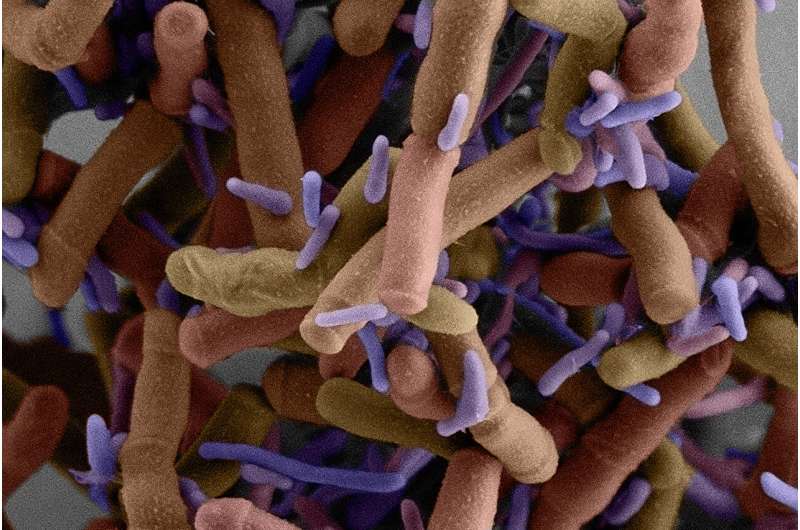This article has been reviewed according to Science X's editorial process and policies. Editors have highlighted the following attributes while ensuring the content's credibility:
fact-checked
peer-reviewed publication
trusted source
proofread
Genetic tools probe microbial dark matter

Patescibacteria are a group of puzzling, tiny microbes whose manner of staying alive has been difficult to fathom. Scientists can cultivate only a few types, yet these bacteria are a diverse group found in many environments.
The few types of Patescibacteria that researchers can grow in the lab reside on the cell surfaces of another, larger host microbe. Patescibacteria in general lack the genes required to make many molecules necessary for life, such as the amino acids that make up proteins, the fatty acids that form membranes, and the nucleotides in DNA. This has led researchers to speculate that many of them rely on other bacteria to grow.
In a study published in Cell, researchers present the first glimpse into the molecular mechanisms behind the unusual Patescibacteria lifestyle. This breakthrough was made possible by the discovery of a way to genetically manipulate these bacteria, an advance that has opened a world of possible new research directions.
"While metagenomics can tell us which microbes live on and within our bodies, the DNA sequences alone do not give us insight into their beneficial or detrimental activities, especially for organisms that have never before been characterized," said Nitin S. Baliga of the Institute for System Biology in Seattle, which contributed many computational and systems analyses to the study.
"The ability to genetically perturb Patescibacteria opens up the possibility of applying a powerful systems analysis lens to rapidly characterize the unique biology of obligate epibionts," he added, in reference to organisms that must live on another organism to survive.
The teams behind the study, headed by Joseph Mougous' lab in the Department of Microbiology at the University of Washington School of Medicine and the Howard Hughes Medical Institute, were interested in Patescibacteria for several reasons.
They are among the many poorly understood bacteria whose DNA sequences pop up in large-scale genetic analyses of genomes found in species-rich microbial communities from environmental sources. This genetic material is referred to as "microbial dark matter" because little is known about the functions it encodes.
Microbial dark matter is likely to contain information about biochemical pathways with potential biotechnology applications, according to the Cell paper. It also holds clues to the molecular activities that support a microbial ecosystem, as well as to the cell biology of the assorted microbial species gathered in that system.
The group of Patescibacteria analyzed in this latest research belongs to the Saccharibacteria. These live in a variety of land and water environments but are best known for inhabiting the human mouth. They have been part of the human oral microbiome at least since the Middle Stone Age and have been linked to human oral health.
In the human mouth, Saccharibacteria require the company of Actinobacteria, which serve as their hosts. To better understand the mechanisms employed by Saccharibacteria to relate with their hosts, the researchers used genetic manipulation to identify all the genes essential for a Saccharibacterium to grow.
"We are tremendously excited to have this initial glimpse into the functions of the unusual genes these bacteria harbor," said Mougous, professor of microbiology. "By focusing our future studies on these genes, we hope to unravel the mystery of how Saccharibacteria exploit host bacteria for their growth."
Possible host-interaction factors uncovered in the study include cell surface structures that may help Saccharibacteria attach to host cells, and a specialized secretion system that might be used for transporting nutrients.
Another application of the authors' work was the generation of Saccharibacteria cells that express fluorescent proteins. With these cells, the researchers performed time-lapse microscopic fluorescent imaging of Saccharibacteria growing with their host bacteria.
"Time-lapse imaging of Saccharibacteria-host cell cultures revealed surprising complexity in the lifecycle of these unusual bacteria," noted S. Brook Peterson, a senior scientist in the Mougous lab.
The researchers reported that some Saccharibacteria serve as mother cells by adhering to the host cell and repeatedly budding to generate small swarmer offspring. These little ones move on to search for new host cells. Some of the progeny, in turn, became mother cells, while others appeared to interact unproductively with a host.
The researchers think that additional genetic manipulation studies will open the door to wider understanding of the roles of what they described as "the rich reserves of microbial dark matter these organisms contain" and potentially uncover yet unimagined biological mechanisms.
This interdisciplinary and collaborative study was fostered by the newly created Microbial Interactions & Microbiome Center (called by its acronym mim_c), which Mougous directs. The mission of mim_c is to lower barriers to microbiome research studies and advance collaborations through connections of like-minded researchers from across disciplines. Here, mim_c was the catalyst joining the Mougous lab with oral microbiome expert Jeffrey McClean in the Department of Periodontics, UW School of Dentistry.
More information: Joseph D. Mougous et al, Genetic manipulation of Patescibacteria provides mechanistic insight into microbial dark matter and the epibiotic lifestyle, Cell (2023). DOI: 10.1016/j.cell.2023.08.017. www.cell.com/cell/fulltext/S0092-8674(23)00906-6
Journal information: Cell
Provided by University of Washington School of Medicine




















